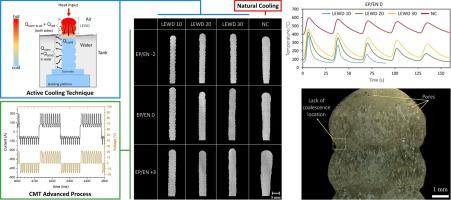Journal of Manufacturing Processes ( IF 6.2 ) Pub Date : 2020-06-20 , DOI: 10.1016/j.jmapro.2020.06.007 Fernando Matos Scotti , Felipe Ribeiro Teixeira , Leandro João da Silva , Douglas Bezerra de Araújo , Ruham Pablo Reis , Américo Scotti

|
Thermal management is a key factor in wire + arc additive manufacturing (WAAM) in order to mitigate heat accumulation and cope with limitations regarding deposition cycle, geometry issues, and mechanical property anisotropies. From the process point of view, the variable polarity Cold Metal Transfer process, a variant of the Gas Metal Arc (GMA) deposition process named as CMT Advanced, stands out as a prominent option to reduce the heat transferred to the layers under deposition, without dropping the deposition rate. In another front, thermally managing the component by employing a technique called Near Immersion Active Cooling (NIAC) throughout all the deposition time has shown to be a promising tool to remove heat from the part under construction. Thus, the current work proposes an evaluation of the CMT Advanced process combined with the NIAC technique for WAAM. The deposition of Al alloy wall-like preforms was made by varying the positive and negative polarity ratio (EP/EN) in the CMT Advanced process and the layer edge to water distance (LEWD) in the NIAC technique. Comparative runs were made with natural cooling instead of the NIAC technique. Electric signals and porosity were quantified to verify the constancy of the process. Thermal cycles of a fixed point of the walls and some of their geometrical features were measured to see the effect of the EP/EN and LEWD parameters in terms of thermal management performance. For the deposition circumstances applied, minor lack of coalescence between layers and also adjacent discontinuities appeared in the waviness valleys of the walls. Such occurrences justified optical and scanning electron microscopy examinations at these locations as complement analyses. Even so, the results clearly showed that the EP/EN parameter is more influential in the control of the layer dimensions and of the preform surface waviness. The LEWD parameter has more effect on reducing the heat accumulation and, consequently, assuring no wall widening as the number of deposited layers is increased. Finally, it was inferred that the possibility of affecting the thermal cycles and geometries of the resultant preforms with two independent thermal management tools expands the windows for finding optimal deposition parameters in WAAM.
中文翻译:

通过CMT Advanced流程和主动冷却技术在WAAM中进行热管理
为了减轻热量积聚并应对沉积循环,几何形状问题和机械性能各向异性的局限性,热管理是焊丝和电弧增材制造(WAAM)的关键因素。从工艺的角度来看,可变极性冷金属转移工艺是气体金属电弧(GMA)沉积工艺的一种变体,称为CMT Advanced,是一种显着的选择,它可以减少在沉积时不转移到沉积层的热量。降低沉积速率。在另一方面,通过在整个沉积时间内采用一种称为近浸式主动冷却(NIAC)的技术对组件进行热管理,已显示出是一种有希望的工具,可以从正在制造的零件中去除热量。从而,当前的工作提出了结合NIAC WAAM的CMT Advanced流程的评估。通过在CMT Advanced工艺中改变正极和负极性比率(EP / EN)和在NIAC技术中改变层边缘到水的距离(LEWD)来沉积铝合金壁状预成型件。使用自然冷却代替NIAC技术进行对比运行。量化电信号和孔隙率以验证过程的稳定性。测量了墙的固定点的热循环及其一些几何特征,以观察EP / EN和LEWD参数在热管理性能方面的影响。对于所施加的沉积情况,在壁的波纹谷中出现了层之间的少量缺乏结合以及相邻的不连续性。这种情况证明了在这些位置进行光学和扫描电子显微镜检查作为补充分析是合理的。即使如此,结果仍清楚地表明,EP / EN参数在控制层尺寸和预成型坯表面波纹度方面更具影响力。LEWD参数在减少热量积聚方面有更大的作用,因此,随着沉积层数的增加,不能确保壁变宽。最后,可以推断,使用两个独立的热管理工具来影响所得预成型坯的热循环和几何形状的可能性扩大了在WAAM中寻找最佳沉积参数的窗口。结果清楚地表明,EP / EN参数在控制层尺寸和预成型坯表面波纹度方面更具影响力。LEWD参数在减少热量积聚方面具有更大的作用,因此,随着沉积层数的增加,不能确保壁变宽。最后,可以推断,使用两个独立的热管理工具来影响所得预成型坯的热循环和几何形状的可能性扩大了在WAAM中寻找最佳沉积参数的窗口。结果清楚地表明,EP / EN参数在控制层尺寸和预成型坯表面波纹度方面更具影响力。LEWD参数在减少热量积聚方面具有更大的作用,因此,随着沉积层数的增加,不能确保壁变宽。最后,可以推断,使用两个独立的热管理工具来影响所得预成型坯的热循环和几何形状的可能性扩大了在WAAM中寻找最佳沉积参数的窗口。


























 京公网安备 11010802027423号
京公网安备 11010802027423号